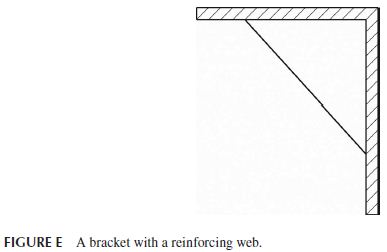Question 6.19: Review Example Analysis 18. In the Comment at the end of the......
Review Example Analysis 18. In the Comment at the end of the example we observed that we were able to obtain the rivet stresses without needing to determine the rivet elongations. Instead, in finding the rivet stresses we simply used the results in Example Analysis 11 where the rivet elongations were determined and used.
Suppose now, with dynamic loading, we are interested in knowing the extent of the downward displacement of the block after it is suddenly placed on the bracket shelf. To this end, suppose that with all geometric and physical conditions for the bracket, block, rivets, and wall support being the same, determine the maximum downward displacement of the block.
Learn more on how do we answer questions.
With the assumptions of bracket and support rigidity, the rivets are the only elastic (or deformable) parts of the structural joint. Therefore, as the loading from the weight of the block is applied to the bracket shelf, the rivets will be stretched and the bracket will rotate counterclockwise as represented in Figure a (in exaggerated form).
Let θ represent the bracket rotation and let δ_{A} and δ_{B} be the elongations of rivets A and B, as in Figure b.
Figure c shows the overall dimensions of the bracket-joint, which are the same as in the previous example analyses. Figure d in turn presents a line drawing showing the rivet deformations (in exaggerated form) and two relevant dimensions, where the vertical and inclined lines represent the inside (or “interface”) surfaces of the bracket and the wall support.
Observe in Figures c and d, if we assume ideal geometry, with no gap between the unloaded interface bracket surface and the support wall surface, and that the rivets are undeformed in the unloaded state, then the undeformed length Ρ of either rivet is simply the sum of the bracket thickness h and the wall support thickenss t. That is,
\ell =h+t (a)
By inspection of Figure d we immediately obtain the relations:
\tan \theta =\delta _{A}/\left(d+e\right)=\delta _{B}/e=\left(\delta _{A}-\delta _{B}\right)/d (b)
Then we see that the rivet deformation are related as:
\delta _{A}=\delta _{B}\left(d+e\right) /e and \delta _{B} = \delta _{A}e/\left(d+e\right) (c)
We can model the rivets as elastic cylindrical bars in tension. Then from the principle of elementary strength of materials, we recall the relations:
\delta =F\ell /AE=\sigma \ell /E (d)
where δ, F, \ell , A, and E are the deformation (elongation), the axial tension force, the rivet length, the rivet cross-section area, and the elastic modulus. By applying Eq. (d) with rivets A and B we have:
\delta _{A}=F_{A}\ell/AE =\sigma_{A} \ell /E and \delta _{B}=F_{B}\ell/AE =\sigma_{B} \ell /E (e)
Recall from Example Analysis 19 that the stresses in rivets A and B due to the sudden loading by the block are:
\sigma _{A}=Wb\left(d+e\right)/ \left(\pi r^{2}\right)\left[\left(d+e\right)^{2}+e^{2} \right] (f)
or
\sigma _{B}=2Wbe/\left(\pi r^{2}\right)\left[\left(d+e\right)^{2}+e^{2} \right] (g)
By substituting these results into Eq. (e) the rivet elongations become:
\delta _{A}=2Wb\left(d+e\right)\ell /E \left(\pi r^{2}\right)\left[\left(d+e\right)^{2}+e^{2} \right] (h)
and
\delta _{B}=2Wbe\ell /E \left(\pi r^{2}\right)\left[\left(d+e\right)^{2}+e^{2} \right] (i)
By substituting the results of Eqs. (h) and (i) into (b) the bracket rotation angle θ is given by:
\tan \theta=2Wbe\ell /E \left(\pi r^{2}\right)\left[\left(d+e\right)^{2}+e^{2} \right] \simeq \theta (j)
Finally, by reviewing Figures a and b, the requested downward displacement δ of the block is seen to be:
\delta=b\theta=2Wb^{2}\ell /E \left(\pi r^{2}\right)\left[\left(d+e\right)^{2}+e^{2} \right] (k)
Comments
1. For a small rotation θ, we can safely approximate tan θ by θ.
2. Observe in the principal result of Eq. (k) that neither the bracket thickness h nor the wall thickness t, appear in the expression. The reason is that the bracket is assumed to be rigid. In practice, however, if either (or both) of h or t is small, the rigidity assumption may be questionable. But also in practice, brackets are usually reinforced by a web as represented in Figure e.




